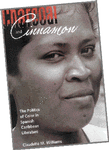
TITLE: Charcoal And Cinnamon: The Politics Of Colour In Spanish Caribbean Literature
AUTHOR: Claudette M. Williams
REVIEWED BY: Balford Henry
"CHARCOAL AND CINNAMON" are two of the racial metaphors used to refer to black and mulatto women in Cuba's classic 19th century novel, "Cecilia Valdes", Claudette W. Williams, senior lecturer in the Department of Modern Languages and Literature, University of the West Indies, Mona, reminds us.
Expanding on the theme of Cirillo Villaverde's book, Ms. Williams explains: "In acknowledging white men's favouring of the mulata (mulatto) over the black woman, Leonardo, the principal white male character, informs his friend: 'If that is your way of saying you do not like cinnamon, then too bad for you Pancho, for it means that you prefer charcoal, a type that is inferior by far".
The question of the inferiority attached to women with black skins in the Diaspora is the basis of Ms. Williams' book, "Charcoal and Cinnamon: The Politics of Colour in Caribbean Literature".
As hinted at by Mr. Villaverde's metaphors, the "mulata's" supposed racial advantage was used to elevate her above the black woman. As cinnamon is more appealing than charcoal, so too was the mulatto woman's perceived aesthetic and sensual attraction more esteemed than the mere utility value imputed to the black woman, she explains.
According to her, black and mulatto women make their first appearance as important figures in the 19th century Cuban novels of slavery. But, increasingly, after the 1920s, writers in the region began to incorporate Afro-Caribbean themes into their work and to formulate theories of cultural identity. This led to the creation of a black/mulatto literary movement, expressing cultural nationalism in the Spanish-Caribbean literature known as Negrismo, in Cuba and Puerto Rico.
This led to the emergence of Francophone Caribbean literature based on the concept of Negritude, with Aime Cesaire its spokesman, differing from negrismo on the basis that it rejected European heritage and called for black cultural autonomy.
Misplaced idealism
Nicolas Guillen, the Cuban writer, is hailed for his work on the subject but severely criticised for dumping anti-black racism with Cuba's colonial past and, dogmatically, suggesting that the revolution had eliminated the class struggle and given power to the working class without regard to skin colour.
Ms. Williams discerned this as idealism, rather than assertion of fact. She added that the claim was challenged, both inside and outside Cuba, by those who have disclosed "the insidious presence of racism in that socialist state."
She credits Spanish Caribbean writers with leading the "transgressive enterprise" altering the boundaries of the region's literary traditions. But, she is satisfied that the strengthening of the feminist movement since the 1970s, has placed gender on the Caribbean cultural and political agenda.
Among the writers she rates for their contribution to this development are the Jamaicans: H.G. DeLisser for his "Psyche" (1959); Phillip Sherlock's "Pocomania" (1959); W. Adolphe Roberts's "The Maroon Girl" (1949); and the poets Una Marson and George Campbell.
Negative
Not all their contributions were positive, for example Mr. DeLisser is chided for being "at pains" to establish that the black female protagonist's striking beauty resides in her "non-Negroid" features.
But, even while Puerto Rican poet Evaristo Ribera Cheremont's "bestial connotations" in reducing the black woman of his "Black Woman Grinds Her Grain" to little more than an inanimate sexual object:
"The black woman grinds her grain
The black woman, a gentle beast
The black woman grinds her grain
on the wooden table...Savage is her joy
When whiteness fills her
When the white man takes
her burning black dough."
It is Marson's verse which offers hope:
"Lord 'tis you did gie me
All dis kinky hair
'Tis you did gie me
All dis kinky hair
And I don't envy gals
What got dose locks so fair
I like me black face
And me kinky hair."
The main fault I find with this book is the very academic nature of her writing, which makes it very unappealing to the less gifted. However, she explains that it is an expansion of her undergraduate work at Stanford University.
Also for English-speaking Caribbeans like myself, the concentration on Spanish writers makes it a little extrinsic. But, in these days of Caribbean integration it should eventually turn out to be a very enterprising project to be rewarded.
Publisher: University Press of Florida



























